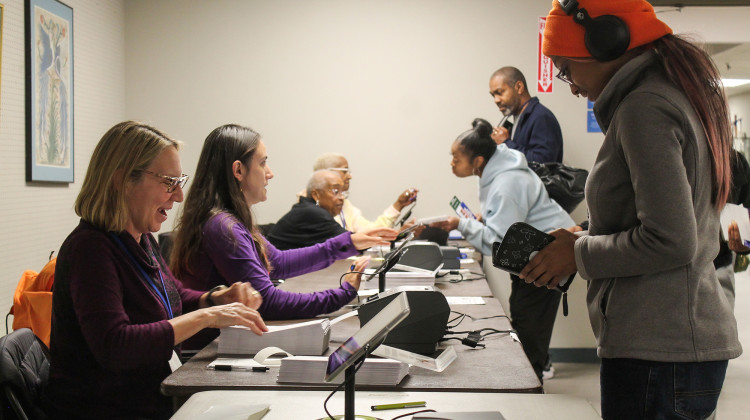
Accelerate’s first graduates come as advocates and experts sound the alarm about a broad lack of education across Indiana's workforce.
FILE PHOTO: Justin Hicks / IPB NewsIndiana lawmakers created a no-interest, no-fee student aid loan for job training called “Accelerate Indiana” in 2021. They used $75 million from federal COVID relief funds for it.
About 50 students are set to graduate and get certifications after the fund’s first year, according to INvestEd. That’s the nonprofit lender lawmakers tasked with administering the loan program.
Accelerate’s first graduates come as advocates and experts sound the alarm about a broad lack of education across Indiana's workforce. Economists still expect the U.S. economy to go into a recession as inflation rises and they warn that people without any kind of post-high school degree or credential are at the most risk.
READ MORE: Indiana Chamber, others ask lawmakers to help the state's under-educated workforce
Join the conversation and sign up for the Indiana Two-Way. Text "Indiana" to 73224. Your comments and questions in response to our weekly text help us find the answers you need on statewide issues.
Unlike more common types of student aid like Free Application for Federal Student Aid (FAFSA), students can’t apply for the aid and then just use the funds at whatever institution they want.
“The success rate, the graduation rate, the income increase, all of these real positive things are really spelled out” in the law that created Accelerate Indiana, said Bill Wozniak, INvestEd vice president of marketing.
To qualify, the training programs must first take six months or less to complete for at least 75 percent of enrolled students. There's a grace period for individual students to take longer if needed, Wozniak said. They are responsible for enrolling students and receive the money directly: 70 percent up-front and 30 percent after the student graduates.
The programs must also not cost more than $7,500, and have 65 percent of graduates employed within three months with average annual earnings over $59,554 within two years.
The programs must also be in one of the following predetermined “key industries:” advanced manufacturing, building and construction, health and life sciences, IT and business services or transportation and logistics.
“And so because of [those requirements], it's something that can help a lot of Hoosiers,” Wozniak said. “But getting the providers and the programs that meet each of those hurdles, each of those items, is what we've really been spending the last year on.”
In Accelerate Indiana's first year, only two training providers met the requirements and received funds.
The two providers are based in Indianapolis. Eleven Fifty Academy is training Accelerate students in cybersecurity, networking, software and web development. Visionary Health Group has been training students to get medical billing and coding certifications.
Since the program launched in late 2021, 249 students have received a combined $1.1 million in Accelerate loans across both providers as of early November, according to data obtained from INvestEd.
There are several other providers on Accelerate’s roster, including 21 Ivy Tech Community College campuses across the state. But, INvestEd has needed time “to get everything set up,” Wozniak said. “The process is almost complete and disbursements should begin shortly.”
Accelerate’s goal is to help Hoosiers get higher-quality, better-paying jobs in key sectors through quick training programs, Wozniak said. “But at the same time, not be really strangled with more traditional student loan debt. And in some cases, they won't repay at all.”
Students who receive this aid don’t have to pay anything back until they get employed. They don’t have to pay it back at all if they get a job that pays less than $42,500 a year or whatever amount they were making before the training.
For those that do get a higher salary, repayments are capped at 5 percent of the student’s income. And if it’s not paid off after 84 months, it's automatically forgiven.
Because of all the strict requirements, it's going to take more time and potentially some changes to expand the availability of Accelerate Indiana, Wozniak said.
“As the last year and a little bit has gone on, we report back and we share information [with state officials and lawmakers] on providers that come forward training programs that come forward,” he said. Some providers, for example, may have programs that fit every other requirement but cost slightly more than $7,500. “[There are discussions] about what is possible if certain things were changed a little bit.”
Any changes would have to be decided by a large group of stakeholders, he added, “making sure that everybody is on the same page or thinks it's a good idea.”
Contact reporter Adam at arayes@wvpe.org or follow him on Twitter at @arayesIPB.
9(MDAyMzk1MzA4MDE2MjY3OTY1MjM5ZDJjYQ000))
 DONATE
DONATE






 Support WFYI. We can't do it without you.
Support WFYI. We can't do it without you.